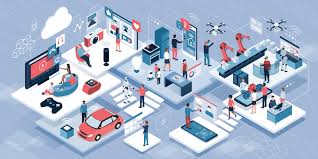
Introduction
The Internet of Things (IoT) is transforming the world significantly. Because of its automation and data gathering and processing possibilities, it has already demonstrated that it is a beneficial tool. IoT platforms are being created in a wide range of industries.
By providing you with a clear understanding of how everything functions and how the various components interact, understanding IoT architecture is the key to arming you with all the knowledge, you need to build a successful IoT project and take advantage of all its benefits.
A system’s components must interact by a set of rules and regulations known as architecture to achieve a specific objective.
Overview
This definition can tell us our understanding of an IoT platform’s definition, development, and contents.
Since projects vary considerably in their scale and use cases, there is no explicit agreement on what constitutes an IoT platform. However, there are several fundamental characteristics that all IoT solutions and projects should have, and these are the ones we will examine.
IoT architecture, in a nutshell, is a framework that specifies:
- The behavior of the physical components (IoT devices)
- How communication is set up on the network.
- How the data is treated (stored and collected)
- What steps are conducted for operation?
- What is the system’s structure?
- How the system functions.
Different Layers of IoT Architecture
Although no two IoT projects and solutions are the same, the fundamental layers have never changed. The three-layer architecture has been the superior design for IoT platforms since the first studies on the topic were conducted.
- Perception: Perception: On this layer are the actual sensors. This is where the data comes from. The data could have been gathered by any number of sensors on the connected device.
- Network: Large volumes of data are moved around the program according to the network layer. This layer links the numerous gadgets and transmits the information to the proper back-end services.
- Application: What users see is the application layer. This could be a dashboard displaying the status of the system’s devices or an application to control a device in a smart home ecosystem.
- Device Layer: The device layer includes all hardware capable of gathering, processing, transmitting, and acting on data over the internet. A sensor is any Internet of Things device component that collects data, such as a security camera or pressure sensor.
- Business Layer: The Business Intelligence layer is another name for this tier. The Business layer, located above the Application layer, describes all matters about stakeholders. Decisions will be made here based on the information gathered and used at the Application layer.
Stages of IoT Architecture
Using a four-stage method is another way to describe an IoT solution architecture. This architecture defines the many components of the IoT solution. Edge computing is more focused in this scenario than the other suggested ideas.
- Devices: The focus of this stage is on real IoT solution devices. These gadgets at the Perception layer might be sensors or actuators. These items either produce data (in the case of sensors) or modify their surroundings (in the case of actuators). The generated data is digitally transformed and sent to the internet gateway stage. Due to the devices’ constrained resources, information is often transferred to the next step in a raw state until a crucial choice needs to be taken.
- Internet gateways: The raw data from the devices will be received at the internet gateway stage, where it will be processed before being shipped to the cloud. This internet gateway might be a standalone unit or physically attached to the device. It would be able to connect to sensors via low-power networks and transmit data to the internet.
- Edge or fog computing: You may wish to send your data to the cloud’s edge to process it as rapidly as feasible. This will enable you to swiftly assess the data and determine whether anything needs your urgent attention. Typically, this layer would only be concerned with recent data necessary for activities requiring speed.
- Datacenter: In this last step, the data is kept for subsequent processing in the cloud or data center. The application and business layers are where the data saved in the cloud can be pushed into dashboards or management tools. At this point, extensive analysis or resource-intensive processes like machine learning training will occur.
Conclusion
IoT projects are being developed across a wide range of industries, and they have already shown to be handy tools due to their automation and data gathering and processing capabilities. Understanding IoT architecture is the secret to equipping yourself with all the knowledge required to develop a practical IoT project. Another way to explain the architecture of an IoT solution is by using a four-stage process. In this case, edge computing is given more attention.
You can also use akenza.io, a self-service IoT platform that lets you build useful Azure IoT Hub products and services. Akenza.io is confident in its ability to help organizations develop IoT solutions by considerably reducing the workload and complexity.
